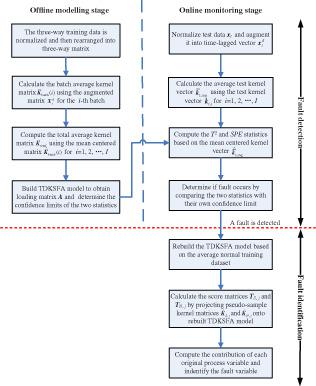当前位置:
X-MOL 学术
›
Can. J. Chem. Eng.
›
论文详情
Our official English website, www.x-mol.net, welcomes your
feedback! (Note: you will need to create a separate account there.)
Dynamic nonlinear batch process fault detection and identification based on two‐directional dynamic kernel slow feature analysis
The Canadian Journal of Chemical Engineering ( IF 1.6 ) Pub Date : 2020-06-24 , DOI: 10.1002/cjce.23832 Hanyuan Zhang 1 , Xiaogang Deng 2 , Yunchu Zhang 1 , Chuanjing Hou 1 , Chengdong Li 1
The Canadian Journal of Chemical Engineering ( IF 1.6 ) Pub Date : 2020-06-24 , DOI: 10.1002/cjce.23832 Hanyuan Zhang 1 , Xiaogang Deng 2 , Yunchu Zhang 1 , Chuanjing Hou 1 , Chengdong Li 1
Affiliation

|
The batch process generally covers high nonlinearity and two‐directional dynamics: time‐wise dynamics, which correspond to inherently time‐varying dynamics resulting from the slowly varying underlying driving forces within each batch duration; and batch‐wise dynamics, which are associated with different operating modes among different batches. However, most existing dynamic nonlinear monitoring methods cannot extract the slowly varying underlying driving forces of the nonlinear batch process and rarely tackle the batch‐wise dynamic characteristics among batch runs. In order to address these issues, a new monitoring scheme based on two‐directional dynamic kernel slow feature analysis (TDKSFA) is developed by combining kernel SFA with a global modelling strategy. In the TDKSFA method, kernel SFA is integrated with the ARMAX time series model to mine the nonlinear and time‐wise dynamic properties within a batch run due to its capability of extracting the slowly varying underlying driving forces. Furthermore, the global modelling strategy is presented to handle the batch‐wise dynamics among batches by calculating the total average kernel matrix of all training batches. After the slow features are extracted, Hotelling's T2 and SPE statistics are built to detect faults. To solve the issue of fault variable nonlinear identification, a novel nonlinear contribution plot inspired by the pseudo‐sample variable projection trajectories in the TDKSFA model is further proposed to identify fault variables. Finally, the feasibility and effectiveness of the TDKSFA‐based fault diagnosis strategy is demonstrated through a numerical system and the penicillin fermentation process.
中文翻译:

基于双向动态核慢特征分析的动态非线性批处理故障检测与识别
批处理过程通常包含较高的非线性和双向动力学:时态动力学,它对应于在每个批处理期间内潜在驱动力缓慢变化所导致的固有时变动力学;和逐批动态,这与不同批次之间的不同操作模式相关。但是,大多数现有的动态非线性监测方法无法提取非线性批处理过程中缓慢变化的潜在驱动力,并且很少解决批处理运行之间的批处理动态特性。为了解决这些问题,通过将内核SFA与全局建模策略相结合,开发了一种基于双向动态内核慢特征分析(TDKSFA)的新监视方案。在TDKSFA方法中,内核SFA与ARMAX时间序列模型集成在一起,以挖掘批处理运行中的非线性和时间动态特性,这是由于其具有提取缓慢变化的潜在驱动力的能力。此外,通过计算所有训练批次的总平均核矩阵,提出了全局建模策略来处理批次之间的批次动态。提取慢速特征后,Hotelling的T 2和SPE统计信息用于检测故障。为了解决故障变量非线性识别的问题,进一步提出了一种基于TDKSFA模型中的伪样本变量投影轨迹启发的非线性贡献图来识别故障变量。最后,通过数字系统和青霉素发酵过程证明了基于TDKSFA的故障诊断策略的可行性和有效性。
更新日期:2020-06-24
中文翻译:

基于双向动态核慢特征分析的动态非线性批处理故障检测与识别
批处理过程通常包含较高的非线性和双向动力学:时态动力学,它对应于在每个批处理期间内潜在驱动力缓慢变化所导致的固有时变动力学;和逐批动态,这与不同批次之间的不同操作模式相关。但是,大多数现有的动态非线性监测方法无法提取非线性批处理过程中缓慢变化的潜在驱动力,并且很少解决批处理运行之间的批处理动态特性。为了解决这些问题,通过将内核SFA与全局建模策略相结合,开发了一种基于双向动态内核慢特征分析(TDKSFA)的新监视方案。在TDKSFA方法中,内核SFA与ARMAX时间序列模型集成在一起,以挖掘批处理运行中的非线性和时间动态特性,这是由于其具有提取缓慢变化的潜在驱动力的能力。此外,通过计算所有训练批次的总平均核矩阵,提出了全局建模策略来处理批次之间的批次动态。提取慢速特征后,Hotelling的T 2和SPE统计信息用于检测故障。为了解决故障变量非线性识别的问题,进一步提出了一种基于TDKSFA模型中的伪样本变量投影轨迹启发的非线性贡献图来识别故障变量。最后,通过数字系统和青霉素发酵过程证明了基于TDKSFA的故障诊断策略的可行性和有效性。











































 京公网安备 11010802027423号
京公网安备 11010802027423号